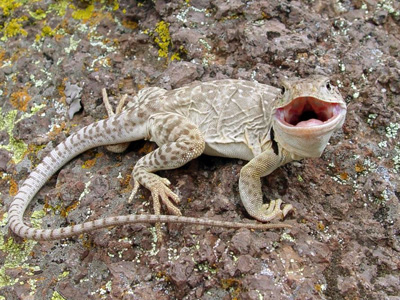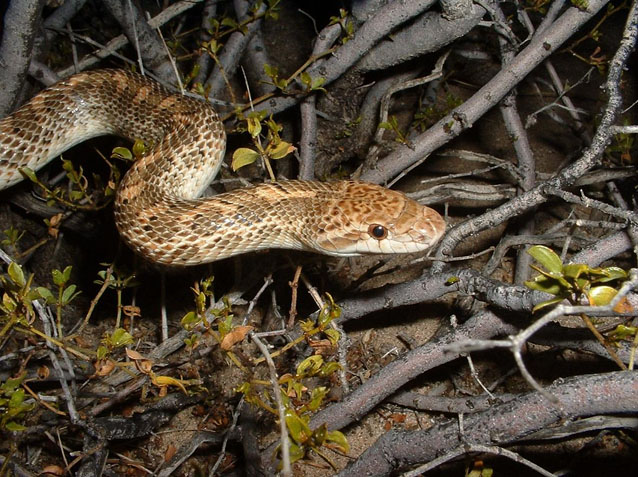Recent surveys for amphibian and reptile species have been conducted in CHDN parks. In 2003 and 2004, the University of Arizona (i.e., Prival and Goode 2005) conducted an inventory of herpetofauna in the six parks of the CHDN– Amistad NRA, Big Bend NP, Carlsbad Caverns NP, Guadalupe Mountains NP, Fort Davis National Historic Site (NHS), and White Sands National Monument (NM).

© Ian Murray
Recent surveys for amphibian and reptile species have been conducted in CHDN parks. In 2003 and 2004, the University of Arizona (i.e., Prival and Goode 2005) conducted an inventory of herpetofauna in the six parks of the CHDN– Amistad NRA, Big Bend NP, Carlsbad Caverns NP, Guadalupe Mountains NP, Fort Davis National Historic Site (NHS), and White Sands National Monument (NM). Little was known about reptiles and amphibians in some of the parks prior to the University of Arizona inventory. The primary objectives of the inventory were to document herpetofauna species, map the distribution of the species found, and determine an approximate relative abundance for each species. The inventory results will aid in future monitoring in the parks. A summary of the results of the project are presented below.
Other efforts to document and/or study the reptiles and amphibians in the CHDN parks have also taken place. In some of the parks inventories had been conducted prior to those in 2003-2004, and some parks had existing species checklists. Such information available for the parks includes:
- a checklist of species at Carlsbad Caverns NP (2007);
- a study of the herpetological community at Rattlesnake Springs (Carlsbad Caverns NP) and an assessment of the abundance of the native Rio Grande leopard frog and the introduced bullfrog (Krupa 1998);
- a study of the distribution of anurans in the Big Bend region and an examination of how abiotic and biotic factors shape the composition and structure of anuran communities (Dayton 2005);
- a checklist of amphibians and reptiles at Big Bend NP (Easterla 2002);
- a study to reassess a lizard survey at Big Bend NP (Leavitt 2007); and
- a checklist, with notes, of herpetofauna at White Sands NM (2002);
- information (with photographs) on herpetofauna at White Sands NM based on observations made from 1971-1977 (McKeever 2009).
- some older inventories at various parks (e.g., LoBello [1976] at Amistad NRA, and Grace [1980] at Guadalupe Mountains NP).
Herpetofauna Inventory at CHDN Parks
As noted above, the inventory of the six CHDN park units was conducted in 2003 and 2004. This section summarizes the findings of the inventory by park. More information on individual park inventories is available from the Chihuahuan Desert Network Reptile and Amphibian Inventories Series.
| Table 1. The number of herpetofauna species documented during the Prival and Goode (2005) inventory of CHDN parks in 2003-2004. | |||||
| Park | # Species | # Amphib Spec. | # Lizard Spec. | # Snake Spec. | # Turtle Spec. |
| Amistad NRA |
45
|
9
|
15
|
17
|
4
|
| Big Bend NP |
59
|
9
|
21
|
26
|
3
|
| Carlsbad Caverns NP |
46
|
8
|
15
|
20
|
3
|
| Fort Davis NHS |
29
|
5
|
12
|
11
|
1
|
| Guadalupe Mountains NP |
48
|
7
|
18
|
21
|
2
|
| White Sands NM |
28
|
6
|
10
|
11
|
1
|
Amistad NRA — Amistad NRA is located in a transition zone between three major plant communities: the Chihuahuan Desert, Edwards Plateau, and Tamaulipan Shrubland (see Figure 1 for location). Three major rivers and the Amistad Reservoir occur in the NRA. Herpetofauna searches were mostly focused along the eastern shore of the reservoir. The animals recorded belonged to 45 species; of the four herpetofauna groups, snakes accounted for the greatest number of species (Table 1). Some species recorded included the Rio Grande leopard frog (Rana berlandieri), Blanchard’s cricket frog (Acris crepitans blanchardi), Merriam’s canyon lizard (Sceloporus merriami merriami), Texas greater earless lizard (Cophosaurus texanus texanus), Texas nightsnake (Hypsiglena torquata janii), Western ribbonsnake (Thamnophis proximus), Rio Grande cooter (Pseudemys gorzugi), and red-eared slider (Trachemys scripta elegans). Four state-threatened species were found at Amistad NRA (Table 2), as well as one non-native species. See the section on non-native species under “Threats” for a discussion of this and other non-native species. Eighty-two percent of the species likely to occur at the park unit were recorded during the inventory.
| Table 2. State-listed and non-native herpetofauna species documented during the Prival and Goode (2005) inventory of CHDN parks. | ||
| Park | State-listed Species | Non-native Species |
| Amistad NRA |
Texas horned lizard (Phrynosoma cornutum), Texas indigo snake (Drymarchon melanurus erebennus), Trans-Pecos black-headed snake (Tantilla cucullata), Berlandier’s tortoise (Gopherus berlandier)
|
Mediterranean house gecko (Hemidactylus turcicus)
|
| Big Bend NP |
Texas horned lizard, Reticulate banded gecko (Coleonyx reticulatus), Trans-Pecos black-headed snake, Texas lyresnake (Trimorphodon biscutatus vilkinsonii)
|
Mediterranean house gecko, American bullfrog (Rana catesbeiana)
|
| Carlsbad Caverns NP |
Gray-banded kingsnake (Lampropeltis alterna), Mottled rock rattlesnake (Crotalus lepidus lepidus), Rio Grande cooter (Pseudemys gorzugi)
|
American bullfrog
|
| Fort Davis NHS |
Texas horned lizard
|
None recorded
|
| Guadalupe Mountains NP |
Texas horned lizard, Hernandez’s short-horned lizard (Phrynosoma hernandesi hernandesi)
|
None recorded
|
| White Sands NM |
None recorded
|
None recorded
|
Big Bend NP — Big Bend NP is the largest protected area of Chihuahuan Desert in the U.S. The park has a substantial range in elevation, which leads to a diversity of plants and animals. The Prival and Goode inventory focused on three mountain ranges that had not been previously surveyed — the Sierra Quemada, the Sierra del Caballo Muerto, and the Mesa de Anguila. Additionally, the inventory was focused on reptiles, because another study (Dayton 2005) was being conducted on amphibians. Fifty-nine species were recorded during the inventory, with the highest proportion of these being snakes (Table 1). Some of these species included the Rio Grande leopard frog, red-spotted toad (Bufo punctatus), Big Bend Canyon lizard (Sceloporus merriami annulatus), Chihuahuan greater earless lizard (Cophosaurus texanus scitulus), Western diamond-backed rattlesnake (Crotalus atrox), Western coachwhip (Masticophis flagellum testaceus), Texas nightsnake, and yellow mud turtle (Kinosternon flavescens). Although amphibians were not the focus of this inventory, the species recorded during the inventory were the same ones documented during the extensive surveys of Dayton (2005) in lowland, upland, and river habitats at Big Bend NP. Four state-listed species were found at Big Bend (Table 2), as well as two non-native species (Prival and Goode 2005). Eighty-six percent of the species likely to occur at the park unit were recorded during the inventory.
Carlsbad Caverns NP — Although Carlsbad Caverns NP is located in the Chihuahuan Desert, it contains several elements of Sierra Madrean, Rocky Mountain, and Great Plains affinity and is characterized by steep limestone canyons. Few permanent sources of water occur in the park aside from Rattlesnake Springs, a wooded riparian area. The park experienced well-below-normal levels of rainfall during the spring and summer 2003 survey, but in 2004 it received 4.5 times the amount of precipitation that it received during the same months of 2003.
During the inventory, individuals representing 46 species were recorded (primarily snakes and lizards; Table 1). Some of these species included the Couch’s spadefoot, Southwestern fence lizard (Sceloporus cowlesi), Chihuahuan spotted whiptail (Aspidoscelis exsanguis), common checkered whiptail (Aspidoscelis tesselata), Northern black-tailed rattlesnake (Crotalus molossus molossus), striped whipsnake (Mastico phis taeniatus), Sonoran gophersnake (Pituophis catenifer affinis), and ornate box turtle (Terrapene ornata ornata). Three state-listed species were found, as well as one non-native species (only at Rattlesnake Spring; Table 2). Researchers documented 92% of the species on the park’s 2002 reptile and amphibian checklist.
Fort Davis NHS — Fort Davis NHS is located in the highly diverse Davis Mountains. The park is of a small enough size that most of it was able to be surveyed by Prival and Goode (2005). A total of 29 species, mostly lizards and snakes, were recorded during the inventory (Table 1). Some of these species included the canyon treefrog (Hyla arenicolor), Big Bend tree lizard (Urosaurus ornatus schmidti), Chihuhuan spotted whiptail, Northern crevice spiny lizard (Sceloporus poinsettii poinsettii), Texas nightsnake, Central Texas whipsnake (Masticophis taeniatus ornatus), Western black-necked gartersnake (Thamnophis cyrtopsis cyrtopsis), and ornate box turtle. One state-threatened species was found during the inventory, and no non-native species were found (Table 2). At least 57% of the species likely to occur on the NHS were observed during the inventory; however, this percentage may be an underestimate because the original species list covered the entire Davis Mountains area and probably included too many species.
Guadalupe Mountains NP — Guadalupe Mountains NP, located in the Chihuahuan Desert (Figure 1), is a diverse area in terms of habitats, plants, and animals. The park contains reliable springs, sand dunes, and forests. The focus of the inventory was McKittrick Canyon, a diverse riparian area, and the Salt Basin Dunes area, characterized by creosote flats, gypsum and quartz dunes. Low levels of precipitation occurred in 2003 and 2004. Forty-eight species were recorded during the inventory (Table 1), including the Rio Grande leopard frog, Plains spadefoot (Spea bombifrons), Chihuahuan spotted whiptail, Southwestern fence lizard, common side-blotched lizard (Uta stansburiana), Western diamond-backed rattlesnake, Northern black-tailed rattlesnake, ring-necked snake (Diadophis punctatus), and desert box turtle (Terrapene ornata luteola). Two species found in Guadalupe Mountains NP were listed as state-endangered (Table 2), but no non-native herpetofauna species were detected. About 87% of the reptile and amphibian species likely to occur in the park were observed. Of note, nine species that were not previously documented in the park were found during the inventory.

© James Borgmeyer
White Sands NM — White Sands NM, located in the Tularosa Basin of the Chihuahuan Desert (Figure 1), is part of the largest white gypsum dune field in the world. On the western side of the park are desert scrub habitat and a large playa. The areas on the west were accessed by crossing the White Sands Missile Range, which had related regulatory requirements that somewhat hampered the survey effort. Animals from 28 species were recorded during the inventory (Table 1), including the Western green toad (Bufo debilis insidior), red-spotted toad, Western marbled whiptail (Aspidoscelis marmorata marmorata), little white whiptail (Aspidoscelis gypsi), Plains striped whiptail (Aspidoscelis inornata llanuras), green prairie rattlesnake (Crotalus viridis viridis), and painted desert glossy snake (Arizona elegans philipi). No state-listed or non-native species were found at the monument during the inventory. About 74% of the reptile and amphibian species likely to occur in the NM were documented.
Part of a series of articles titled Amphibians and Reptiles in the Chihuahuan Desert.
Last updated: August 16, 2017
